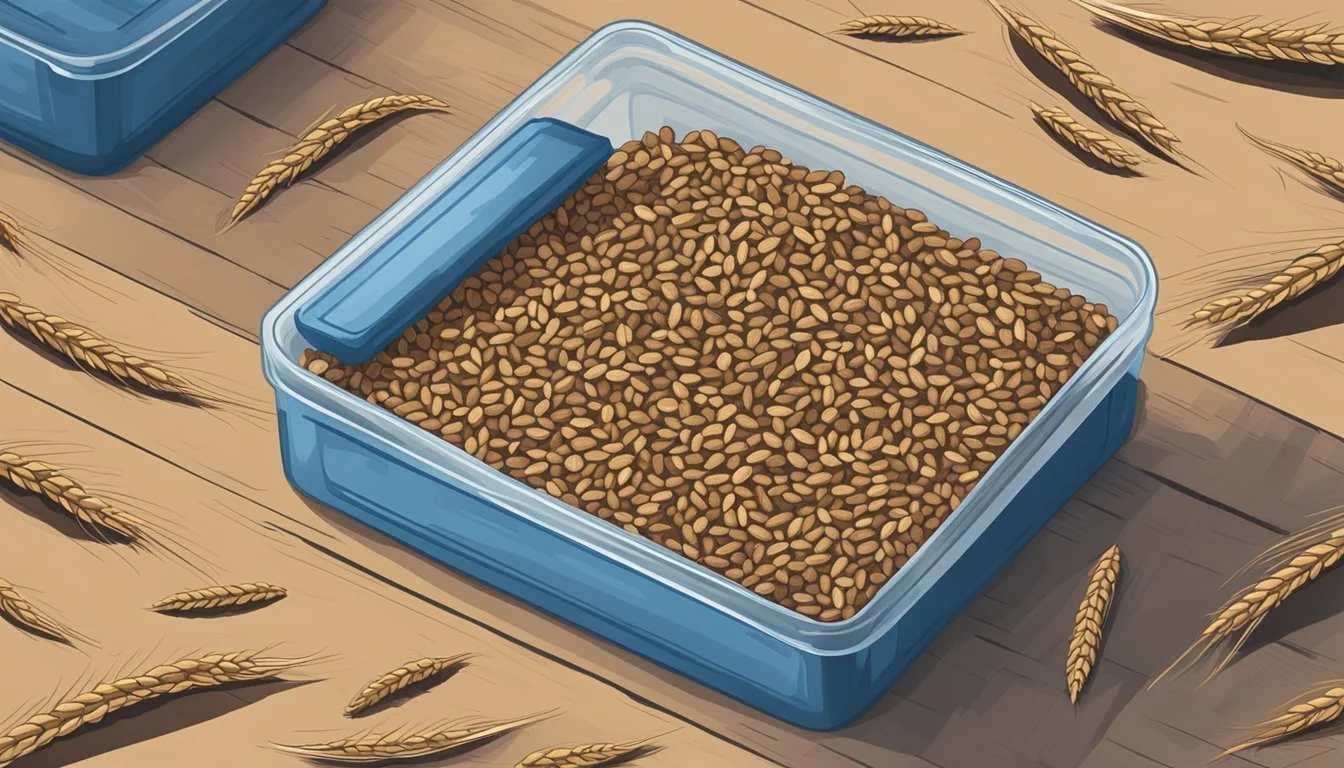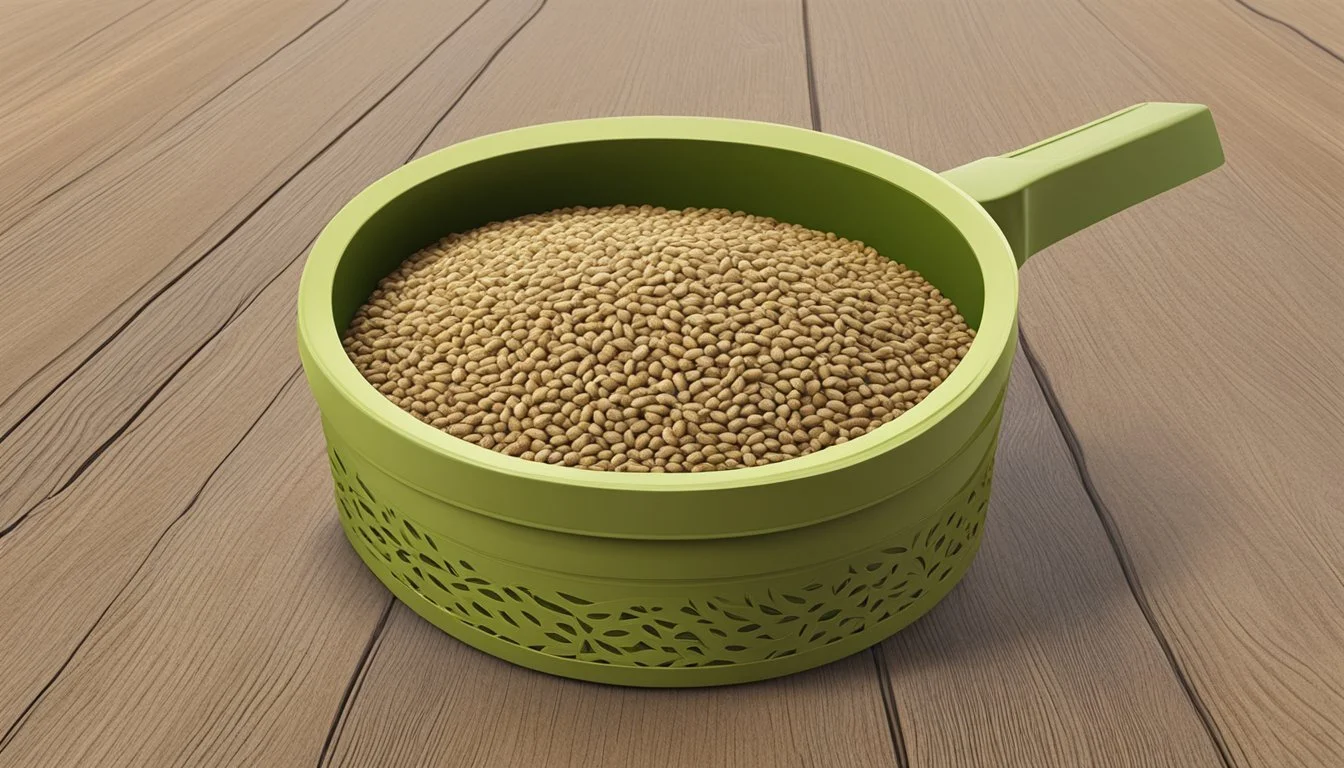How Long Do Rye Berries Last?
Shelf Life and Storage Tips
Rye berries, the whole, unprocessed kernels of rye grain, are known for their robust flavor and health benefits. Their shelf life, however, is a matter of proper storage and understanding the nature of the grain. When stored in a cool, dry pantry in airtight containers, rye berries can maintain their freshness for about 6 months. For those looking to extend their shelf life further, freezing offers a solution, effectively preserving their quality for up to a year.
However, the freshness of rye berries is not solely contingent on storage, as it is also influenced by the initial quality of the grain and the environment in which they are kept. The cool and low-humidity conditions of a refrigerator or freezer slow down oxidation, the process largely responsible for the degradation of the berries' taste and nutritional value. It is important to note, though, that even within these ideal conditions, the actual shelf life can vary, and consumers may occasionally encounter changes in flavor or aroma, indicating that the grains are past their prime.
Understanding Rye Berries
Rye berries are a versatile and nutritious whole grain with varied culinary applications. Understanding their nature and benefits helps in integrating them into a diet effectively.
Definition and Types
Rye berries are the whole, unprocessed seeds of the rye plant. They are related to wheat berries and are part of the whole grains family, which also includes barley and oats. There are primarily two types of rye:
Winter Rye: Planted in the fall and harvested in the early summer.
Spring Rye: Planted in the spring and harvested in the fall.
Nutritional Profile
Rye berries are rich in nutrients. They contribute a significant amount of fiber and contain essential vitamins and minerals. Here's a brief overview of their nutritional content:
Fiber: Promotes digestive health.
Vitamins: Includes B-vitamins, necessary for energy metabolism.
Minerals: Such as magnesium and phosphorus.
Rye contains gluten, although typically in lower amounts than wheat, making it unsuitable for those with celiac disease or gluten sensitivity.
Culinary Uses
In the kitchen, rye berries are praised for their hearty, earthy flavor. They can be used in various ways including:
Soups and Salads: For a nutritious addition.
Pilafs: As a substitute for rice or quinoa for a different taste and texture.
Baking: Ground to flour for bread and other baked goods.
Rye's versatility makes it a valuable grain for culinary experimentation and health-conscious cooking.
Storage Fundamentals
When storing rye berries, it is crucial to focus on the container and environment to maximize shelf life. Specific conditions such as temperature and moisture levels are determinants for their longevity.
The Importance of Airtight Containers
An airtight container is essential for preserving the quality and longevity of rye berries. A proper seal prohibits the entry of air and pests, which can spoil the grains or introduce contaminants. Options for airtight storage include:
Large sealable plastic bags
Snap-top plastic containers
Glass containers with tight seals
Shelf Life Variables
Several factors influence the shelf life of whole grains like rye berries. Storing them in a cold, dry place away from direct light will help maintain their integrity. A storage chart or whole grain storage chart can provide specific guidelines, but generally:
Environment Expected Shelf Life Pantry (room temperature) Up to 6 months Freezer Up to 1 year
Maintaining a stable temperature and low humidity is critical, and the freezer can extend the shelf life significantly.
Optimal Storage Conditions
The longevity of rye berries greatly depends on storage conditions that limit exposure to oxygen and humidity. Using airtight containers is essential for maintaining freshness, whether stored at room temperature, in the refrigerator, or in the freezer.
Room Temperature and Pantry
At room temperature, rye berries should be stored in a cool, dry, and dark place to ensure maximum freshness. Homeowners can use plastic or glass airtight containers, such as Mason jars, which prevent oxygen and moisture from spoiling the grains. Under these conditions, rye berries typically remain fresh for up to six months.
Location: Dark pantry or cupboard.
Containers: Airtight plastic or glass.
Shelf Life: Up to 6 months.
Refrigerator Storage
Refrigeration is typically not recommended for whole rye berries, as condensation inside the container can do more harm than good. If one chooses to refrigerate, they should ensure the berries are in a completely airtight container to minimize humidity impacts. However, this is only advised if there are concerns about infestation or extreme temperatures.
Containers: Completely airtight containers to prevent moisture ingress.
Considerations: Possible condensation issues, use when necessary.
Freezer Storage
For long-term preservation, the freezer is an excellent option. By placing rye berries in sealed airtight containers or heavy-duty freezer bags, homeowners can extend the grains' freshness period to 2 to 6 months. It is important to label the container with the date of freezing and to let the berries warm to room temperature before use to prevent condensation.
Containers: Airtight containers or heavy-duty freezer bags.
Shelf Life: 2 to 6 months.
Defrosting: Allow to reach room temperature before use to avoid moisture issues.
Maximizing Shelf Life
When it comes to rye berries, their shelf life can be significantly extended with proper storage techniques. Ensuring an airtight environment and controlling climate factors are crucial steps in preserving the grains’ freshness.
Proper Sealing Techniques
To extend the shelf life of rye berries, they must be stored in airtight containers. Airtight sealing is essential as it prevents moisture and air from entering, which can accelerate spoilage. One may consider using:
Sealable plastic bags: These should be of high quality to ensure a good seal.
Snap-top plastic containers: Ensure the lid closes tightly to secure the contents.
Glass jars with tight-fitting lids: These provide a visual check of the rye berries' condition without opening.
The protective bran layer of the rye berries keeps them fresh, but once it is compromised, the shelf life diminishes rapidly due to oxidation.
Controlling Climate Factors
The environment in which rye berries are stored significantly affects their shelf life. To protect them from oxidation and spoilage, consider the following:
Temperature: Store the rye berries in a cool, dry place. A pantry can suffice for short-term storage, whereas longer storage benefits from refrigeration or freezing.
Humidity: High humidity can lead to mold growth. Ensure the storage area is dry.
Climate: If in a particularly warm or humid climate, refrigeration may be necessary to extend the berries' shelf life beyond a few months.
In a cold climate, rye berries can last well when stored in a dry, airtight container, potentially extending their shelf life up to a year.
Common Storage Issues
When storing rye berries, one must be vigilant about spoilage and infestations, which can compromise the quality and safety of the grains. Proper storage methods are crucial for maintaining their freshness.
Signs of Spoilage
Odor: Fresh rye berries should have a slightly nutty aroma. The presence of unusual odors, often musty or sour, can indicate spoilage due to oxidation or the growth of mold.
Texture and Appearance: Rye berries should be firm and dry. Any signs of moisture, which can lead to a clumpy texture, or visible mold suggest that the berries are no longer good to consume.
Taste: Although it's not advisable to taste grains that show visual signs of spoilage, a loss of natural sweetness and a stale or off flavor are indicative of spoiled grains.
Preventing Infestations
Storage Containers: To prevent bug infestations, store rye berries in airtight containers. Options include food-grade buckets, glass jars with tight seals, or vacuum-sealed bags.
Environment: Keep the storage area dark and cool. Pantry shelves away from heat sources or a basement are suitable options.
Regular Inspection: Periodic checks for signs of infestation, such as the presence of bugs or larvae, are essential. Rye berries should be free of these pests to ensure they remain safe to eat.
By understanding and addressing these common storage issues, one can maintain the quality of their rye berries effectively.
Using Rye Berries in Cooking
Rye berries, the whole, unprocessed kernels of rye, can be a versatile grain when prepared properly. They bring a robust flavor and hearty texture to a variety of dishes including salads, soups, and bread.
Preparation Steps Before Cooking
Before cooking, rye berries should be thoroughly rinsed under cold water using a fine mesh strainer. To shorten the cooking time and ease digestion, they can be soaked in water overnight. Once soaked, drain the water and the rye berries are ready to be cooked.
Cooking Methods and Recipes
To cook rye berries, bring a pot of water to a boil, add a pinch of salt, and then the grains. Reduce heat to maintain a low simmer, and cook for 50-60 minutes until they are tender yet chewy. Here are two specific ways to incorporate cooked rye berries into dishes:
Salads: Combine cooled rye berries with fresh vegetables and a vinaigrette dressing for a nutritious salad.
Soups: Add cooked rye berries to soups for added texture much like barley or rice.
Furthermore, rye can be ground into rye flour (how long does rye flour last?) for baking bread or can be rolled like oats to create rye flakes (how long do rye flakes last?). These flakes can be used similarly to rolled oats (how long do rolled oats last?), for instance, in making a wholesome rye risotto.
Safety and Health Considerations
When considering the safety and health aspects of rye berries, one must take into account their gluten content and their role as a whole grain in a nutritious diet.
Allergies and Gluten Content
Rye berries contain gluten, a protein that can trigger allergic reactions or sensitivities in individuals with celiac disease or non-celiac gluten sensitivity. It is essential for these individuals to avoid rye and other gluten-containing grains such as wheat and barley to prevent health complications.
Benefits of Whole Grain Consumption
Consuming whole grains, including rye berries, offers numerous health benefits. Rye is a whole grain that retains its nutrient-rich bran and germ during processing, providing a source of dietary fiber and essential nutrients like B vitamins, iron, phosphorus, magnesium, and zinc. Including whole grain flours in one's diet supports digestive health and may contribute to a reduced risk of chronic diseases.
Fiber: Essential for digestive health and can help lower cholesterol levels.
Organic: Organic rye berries may have lower pesticide residues.
Nutritious: A nutrient-dense choice packed with vitamins and minerals.
Vitamins and Minerals: High in B vitamins and minerals like iron, which are pivotal for energy metabolism and overall health.
Purchasing and Labeling Tips
When purchasing rye berries, one should pay close attention to the quality of the grains and the information on the labels. The handling of rye berries from the point of purchase to storage significantly impacts their shelf life.
How to Choose High-Quality Rye Berries
To ensure the purchase of high-quality rye berries, one should look for whole grains that are uniform in color and size. The grains should be free of moisture and any signs of damage or infestation. Organic rye berries are a sought-after option as they are generally grown without synthetic pesticides and fertilizers.
Understanding Labels and Expiration Dates
It is important to read labels carefully. The label should provide clear information about the expiration date, which can give an indication of the grain's freshness and how long it will last. Additionally, labels may specify if the rye berries are whole or cracked, with intact grains typically having a longer shelf life. The designation of whole grains on a package indicates that the entire grain kernel is present, which is beneficial for maximum nutrient retention.
Alternative Grains Comparison
In assessing rye berries' shelf life, it's valuable to consider how they stack up against other grains in terms of preservation and suitability as alternatives.
Comparing Rye to Other Grains
Rye Berries: Typically, rye berries have a similar shelf life to that of wheat berries, which can last for many months when stored properly in a cool, dry place. Rye offers a lower gluten content which can be advantageous for those with sensitivities.
Wheat Berries: Similar in nutrition to rye, with a shelf life of about 6 months to a year.
Brown Rice: High in oils, brown rice has a shorter shelf life, around 6 months to 1 year.
White Rice: Including varieties such as jasmine and arborio, can last up to 5 years.
Alternative Whole Grains Longevity:
Quinoa, Amaranth, Buckwheat: These pseudocereals do not contain gluten and can last up to 2 years.
Spelt (how long does spelt last?), Millet, Sorghum: (how long does sorghum last?) These alternatives to wheat and rye also have a great shelf life, often around 1-2 years when stored correctly.
Storing these grains in an airtight container is vital in preserving their freshness and extending their shelf life.
Identification of Substitute Grains for Rye
When considering substitutes for rye berries in recipes or for dietary needs, the following grains can be viable options:
Quinoa and Amaranth: Both have a similar nutritional profile to rye, offering high levels of protein and essential amino acids.
Millet and Sorghum: These grains are suitable for gluten-free diets and provide comparable fiber content.
Spelt: While spelt contains gluten, it is often more digestible than conventional wheat and can be a good alternative for those who can tolerate some gluten.
Each grain has distinct cooking times and water ratios, so adjustments will be necessary when substituting for rye berries.
Cultural and Regional Aspects
Rye's role as a staple in the diet varies significantly by culture and region, with some countries adopting it as a primary source of grain while others use it for specific culinary applications. This section explores how rye is interwoven with cultural food choices, particularly in Scandinavia, and its diverse uses globally.
Rye in the Scandinavian Diet
In Scandinavian countries, rye is deeply ingrained in the traditional diet. Rye bread, known for its dense texture and hearty flavor, is a staple food in this region. It's not uncommon for rye to be consumed at multiple meals throughout the day in various forms. For instance, porridges made from rye are a common breakfast choice, providing a nutritious start to the day. They integrate the grain's full nutrient profile, which includes high fiber content. The cultural food choices of Scandinavia have historically leaned on the cereal grain due to its adaptability to the colder climate, where rye can grow better than other grains, like wheat.
Norway: Rugbrød (rye bread) is commonly used for open-faced sandwiches.
Sweden: Rye crispbread known as knäckebröd is a popular, crunchy alternative.
Finland: Traditional rye porridge, known as ruispuuro, is a comforting breakfast food.
Global Varieties and Uses of Rye
Around the world, rye appears in many forms, reflecting local agricultural practices and cultural preferences. While its production makes up only a fraction of wheat's global output, it is central in countries like Russia, Germany, and Poland. In Russia and Poland, rye bread remains a significant part of the diet, often associated with traditional cultural food choices. Germany's well-known pumpernickel bread is another prime example of rye's cultural significance.
The use of rye is not limited to bread; it extends into beverages such as beer and whiskeys, and to a lesser degree, vodkas. The grain's robust flavor profile translates well into these alcoholic beverages, and rye whiskeys, particularly from North America, have gained international recognition. Rye is valued for its versatility and has seen a modern resurgence as chefs and food enthusiasts look to ancient grains to enrich contemporary diets.
Sustainable Storage Practices
When storing rye berries sustainably, choosing the right materials and understanding the consequences of storage methods on longevity and environmental impact are critical.
Eco-Friendly Packaging Options
For rye berry storage, eco-friendly packaging options are essential to minimize environmental impact. Airtight containers made of glass are a sustainable choice, as glass is recyclable and does not degrade in quality over time. When selecting plastic bags, one should opt for those that are reusable or made from biodegradable materials. These options not only maintain the freshness of rye berries but also align with a commitment to environmental responsibility.
Glass Containers: Reusable, recyclable, and do not interact with the grains.
Biodegradable Plastic Bags: A more sustainable alternative to traditional plastics.
Long-Term Impact of Storage Choices
The long-term impact of storage choices on both the shelf-life of rye berries and the environment is significant. Using long-lasting, durable containers such as airtight glass containers can prevent frequent replacements and reduce waste. Additionally, proper storage in airtight containers, whether glass or plastic, can extend the shelf life of rye berries, therefore, reducing food waste.
Airtight Containers: Minimize oxidation and extend shelf life.
Material Durability: Influences the frequency of replacement and waste generation.
By using sustainable materials and considering the long-term effects, one ensures the freshness of rye berries while also contributing to environmental conservation.
Advanced Topics
The longevity of rye berries is significantly influenced by advancements in grain preservation and storage methods. These improvements help maximize shelf stability and ensure optimal freshness over time.
The Science of Grain Preservation
Grain preservation science focuses on prolonging shelf life and maintaining the nutritional quality of rye berries. Protection against elements like moisture, oxygen, and pests is crucial. Moisture control is essential, as excessive moisture can lead to mold growth, which compromises the grain's integrity. Oxygen exposure can lead to oxidation and rancidity, reducing shelf life and nutritional value. Careful temperature management is necessary to minimize the risks, as lower temperatures generally prolong the storage life of rye berries. Innovation in grain preservation also includes examining the glycemic index of grains, as stable blood sugar levels are an important health consideration for consumers.
Innovative Storage Solutions
Storage innovation plays a vital role in preserving the quality and extending the shelf life of grains like rye berries. Practical and innovative storage solutions include:
Vacuum Sealing: Removes air from the storage container to reduce oxidation.
Airtight Containers: Keeps out moisture and pests, preserving the grain's quality.
Freezing: An effective method to extend shelf life for up to 6 months, and possibly more when properly sealed.
Desiccants: Including silica gel packets to absorb moisture and protect against spoilage.
By implementing these advanced storage solutions, consumers and suppliers can maintain rye berries in a shelf-stable condition for a prolonged period, preserving both their nutritional value and taste.
DIY Solutions and Tips
Implementing effective homemade storage techniques and creating a personalized storage chart are key to extending the shelf life of rye berries.
Homemade Storage Techniques
One can store rye berries in a mason jar or freezer bag to ensure their longevity. Rye berries must be kept in a cool, dry place away from direct sunlight. Before storing, it's imperative to use a fine mesh strainer to rinse the berries thoroughly. For those looking to freeze rye berries, individuals should dry them completely to prevent ice crystals from forming. Once dry, placing them in a freezer bag allows for convenient, long-term freezing.
Crafting Your Storage Chart
It is beneficial to create a storage chart to track the shelf life of rye berries. A chart should ideally include the following:
Date of Purchase: Mark the date when the rye berries are bought.
Storage Method: Indicate whether the berries are stored in a pantry, fridge, or freezer.
Expected Shelf Life:
Pantry: Up to 6 months
Fridge: Up to a year when kept in an airtight container
Freezer: Beyond a year if properly sealed in a freezer bag or mason jar
Notes: Any peculiarities like odor changes or texture, which may signal spoilage.
Add a dash of fine salt when preparing rye berries to enhance flavor and ensure they retain their texture.














